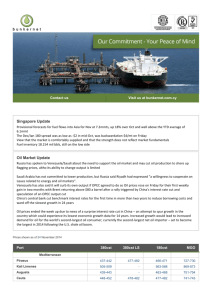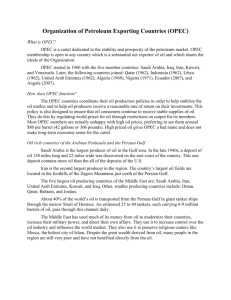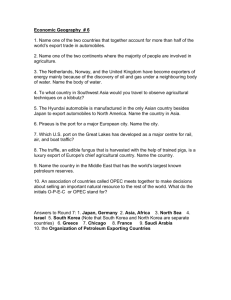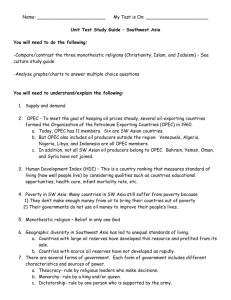Introduction
advertisement
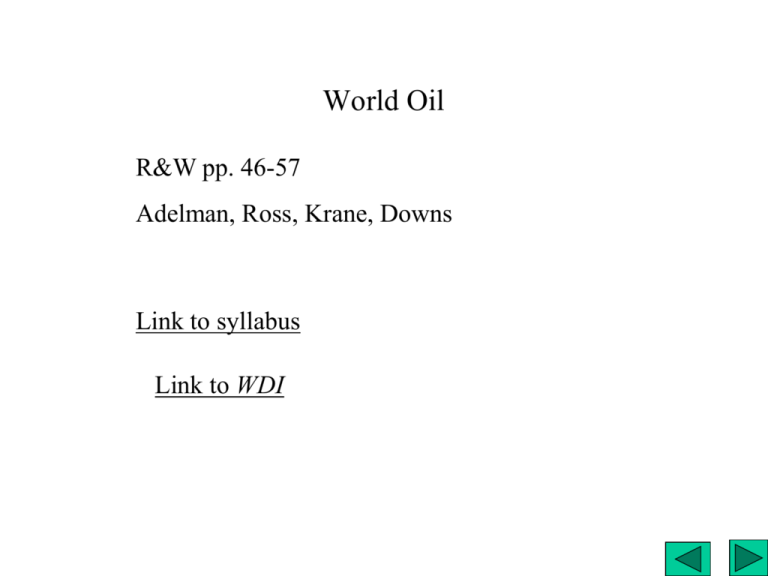
World Oil
R&W pp. 46-57
Adelman, Ross, Krane, Downs
Link to syllabus
Link to WDI
World Production
of Oil
U.S. Oil Production,
Consumption, Imports
Sources of U.S. Oil, 1973-99: (DOE)
Oil Production and Exports, 2005
3.1 World Petroleum Supply and Disposition, 2005
(Thousand Barrels per Day)
Crude
Crude
Oil
Oil
Oil
Oil
Region/Country
Production
Exports
Production
Exports
Canada
3,092 1,360
Iraq
1,889 1,432
United States8,322
32
Kuwait
2,672 1,642
Mexico
3,784 2,022
Qatar
1,111
933
Venezuela 2,867 1,571
Saudi Arabia
11,096 7,690
Norway
2,978 2,339
United Arab2,845
Emirates
2,315
United Kingdom
1,861 987
Algeria
2,091 1,430
Kazakhstan 1,337 1,147
Angola
1,261 1,220
Russia
9,511 5,222
Libya
1,721 1,351
Iran
4,239 2,574
Nigeria
2,631 2,428
World Total
84,579 44,321
Changes in Net Exports of Oil 1997-2004 (1,000 b/d)
Petroleum
Increase
Decrease
Net Exporters
Russia
Net Importers
3,077
Brazil
573
Saudi A.
Iraq
Algeria
Mexico
Qatar
717
861
458
285
271
Japan
473
Indonesia
U.K.
-707
-676
USA
China
-2,925
-2,592
Venezuela
-466
India
Source: Calculated using BP data.
-707
Change in Net Exports of Natural Gas, 1997-2004
converted to oil equivalent, in thousand barrels/day
Net Exporters
Increase
Decrease
Norway
740
Qatar
454
Trinidad
433
Canada
243
Mexico
-221
Net Importers
S. Korea
Source: Calculated from BP Statistical Review, 2005
-323
Shale oil and shale gas resources are globally abundant
June 10, 2013
World Reserves
Proved oil reserves at end 2003
Source: BP. Data is obviously out of date.
Canadian Oil Sands
And the Country with the Second Greatest Proved Oil Reserves
Worldwide Is . . . Six months ago, “Iraq” was the correct completion
of the above phrase. Its 112.5 billion barrels of proved oil reserves was
second only to Saudi Arabia’s imposing 259.3 billion barrels. However,
in the December 23, 2002, issue of the Oil & Gas Journal, proved oil
reserves in Canada catapulted from an estimated 4.9 billion barrels in
2002 to an amazing 180 billion barrels in 2003. How was this possible?
A methodology change by the Oil & Gas Journal now includes western
Canada’s oil sands in its definition of proved oil reserves. Heretofore, oil
sands were considered “nonconventional” and were not counted as proved
oil reserves; however, dramatic reductions in development and production
costs have brought oil sands into the realm of economic viability. With
today’s technologies and oil prices, it is entirely appropriate to consider
western Canada’s vast oil potential as being commensurate with
“conventional” crude oils.a
Source: US DoE http://www.eia.doe.gov/oiaf/ieo/oiltext_box.html
PRICES
Real and nominal prices
Lots of the U.S. price goes to taxes; about half goes to production
Cost of production in MENA is quite low
Dramatic differences in output/well
Fig. 3.3 p. 52 (R&W). Crude Oil Real Prices, 2004 US$
Iran-Iraq
War
Fall of
Shah
Embargo
New Supplies,
World Recession
Iraq-Kuwait
Asian
Crisis
Nominal and Real Oil Prices, 1860-2010
Source: BP: Statistical Review of World Energy, 2011
U.S. Breakdown of the price of gasoline at the pump
Price of Gasoline/World Price 2000-08
Iran
Saudi Arabia
Egypt
Algeria
United Arab
Emirates
0.18
0.28
0.37
0.37
Canada
Mexico
India
Brazil
0.85
0.85
1.05
1.19
0.40
Spain
1.29
Germany
France
Italy
Korea,
United
Kingdom
1.63
1.63
1.67
1.70
United States
0.66
Poland
1.37
Netherlands 1.79
Russia
Jordan
0.69
0.77
Japan
Sweden
1.52
1.61
Norway
1.78
1.89
Source: WDI. The world price averaged about US$ 0.90/liter
Costs of Production, (US$/barrel) 1960
“Unit costs of maintaining and expanding crude petroleum
production in Middle East and other areas.”
Middle East
0.15
United States 1.63
Venezuela
0.24
Canada
2.53
Far East
0.62
Posted prices in the Middle East were about $1.80; in US it was $3.28
Source: Issawi (1963) Economics of Middle Eastern Oil (p. 54) citing Chase Manhattan B
Exploration and Development Costs
Source: OECD/IEA: WEIO
Time period is early 2000s
Output/Well (barrels/day). 2003
Output/day
# WellsQ/well
Canada
Mexico
USA
Brazil
Venez.
U.K.
Russia
Algeria
Libya
1,652 55.9
30
3,789
3.1 1,209
5,777 520.3
11
1,496
8.9 169
2,230 11.6 193
2,065
1.0 2,001
8,426 119.0
71
1,560
1.4 1,114
1,420
1.5 925
Output/day
# WellsQ/well
Nigeria
Iran
Kuwait
Oman
Qatar
Saudi A.
Abu Dhabi
China
Indonesia
2,180
3,780
1,870
821
892
8,480
1,925
3,130
1,150
2.7
1.4
1.0
2.6
0.6
1.8
1.3
82.4
8.3
Source: World Oil Sept 2004. Output and #wells in thousands.
823
2,671
1,968
322
1,581
4,764
1,481
38
139
Surplus Capacity - OPEC
OPEC Spare Production Capacity, 2011, 2003
Source: Energy Economist.com
Opec Capacity Utilization Rates
Source: Shihad-Eldin (2004) Oil Output and Investment Prospects
U.S. Strategic Petroleum Reserve (in days)
Joined
OPEC
Algeria
Angola
Ecuador
Iran
Iraq
Kuwait
Libya
Nigeria
Qatar
Saudi A
U.A.E.
Venezuela
Population Production
(millions) (mn brl/day)
1969
2007
2007
1960
1960
1960
1962
1971
1961
1960
1967
1960
Total
Former
Members
Gabon
Indonesia
37.4
18.1
15.2
78.9
31.1
2.6
5.6
170.1
2.0
26.5
5.3
28.0
2.13
1.94
0.49
4.17
3.20
2.49
2.21
2.21
1.21
8.80
2.80
2.47
33.27
Left OPEC
1994
2009
OPEC
Members
(formed 1960)
OPEC
Secretary General Abdalla Salem El-Badri
Libyan, born 1940.
Bus Ad. Degree from Florida Southern U.
First professional job was with Esso (Exxon/Mobil)
c.v.
OPEC Countries: Crude Oil Production
(1,000 b/d)
OPEC Countries:
Crude Oil
Saudi Arabia
12,000
8,000
Iran
4,000
0
1970
1980
Iraq
1990
2000
2010
Iran
Iraq
Kuwait
Libya
Nigeria
Saudi Arabia
U.A.E.
Venezuela
Saudi oil minister rules out output hike
Friday, April 11, 2008
Compiled by Daily Star staff
Saudi Oil Minister Ali Naimi said on Thursday that there were not
enough buyers of oil to justify an increase in oil production, despite
high prices, and he added that fossil fuels should supply the bulk of
global energy needs for at least the next 50 years. Naimi also slammed
biofuels, saying they did not protect the environment or help supply
security, but added that solar power had to be considered one of the
best clean-energy sources.
Speaking outside an international oil conference in Paris as the price of
oil hovers at near-record levels, he said there were not enough buyers
of oil in the market to absorb extra output.
Asking where the buyers were, he said that if more buyers emerged,
then "we" would sell. But there were no such buyers, he argued.
Refiner Acquisition Cost, 1996-2002
It used to be said that OPEC has a target price range.
mt prefers a description that Saudis are price setters, and other
OPEC countries accept that price, without significant production
Changes..
Non-OPEC Production
Soviet Oil Production
Russian Oil Production, 1994-
Oil
Corridor
Gulf Oil
Source: Longrigg (1967) Oil in the Middle East p. 493
Mediterranean Gas Finds
Syrian
Claim
Lebanon’s
Claim
Disputed betwe
Lebanon & Isra
Israeli
Claim
Egyptian Claim
Palestinian
Claim
Source: Antreasyan Journal of Palestine Studies Spring, 2013
Green is Oil,
Red is Gas
Europe & Russia: Petroleum Economist
New Energy Pipelines for Europe
Source: Der Spiegel online, March 14, 2010
Oil & Gas: MENA & North Africa. Petroleum
Economist
Green is Oil,
Red is Gas
Africa Oil. Source: World Oil 2002
North Sea Oil
Source: World Oil
2002
Oil and Gas in South-East Asia
Mexican Oil
Source: World Oil, 1984
Colombia and Venezuela Oil
Source: World Oil, 2002
Brazil: Off-shore oil. Campos Basin
Source:
World Oil
One mile to the
ocean floor,
then another
mile or two.
Off-shore Petroleum Drilling, Brazil
Source: Gail Tverberg (2008) Peak Oil Science Curriculum
Demand
Consumption: Barrels/day/1000 population
Canada
64
Mexico
19
USA
70
Brazil
13
Belgium
58
France
34
Italy
34
Germany
36
Netherlands 51
Sweden
41
Switzerland
38
Turkey
10
United Kingdom31
Russia
17
Iran
20
Israel
41
Kuwait
117
Saudi Arabia 64
U.A.E.
123
Egypt
9
Australia
46
China
3
India
2
Indonesia
5
Japan
46
Korea, S.
49
Highest levels in Gulf countries, (not US and western Europe)
Oil Import Dependence for Some OECD Countries for the Year
Country/Region
Oil Consumption Net Oil ImportsNet Oil Imports as a
(Million Barrels per(Million
Day) Barrels per Day)
% of Oil Consumption
Net Oil Importers
United States
France
Germany
Italy
Spain
Sweden
Switzerland
Turkey
Japan
South Korea
OECD total
OECD Europe
20.034
2.060
2.677
1.874
1.544
0.346
0.259
0.653
5.578
2.168
41.113
15.502
11.238
1.865
2.544
1.671
1.506
0.384
0.255
0.607
5.501
2.256
31.508
8.651
56.1%
90.5%
95.0%
89.2%
97.5%
111.0%
98.5%
93.0%
98.6%
104.1%
76.6%
55.8%
United States: Petroleum Supply Annual 2003
Others: International Energy Agency, Monthly
Data Service, February 10, 2005
Energy Consumption in the US 1776-2012
World Energy Intensity, by Region (DOE)
(US?) Energy Consumption per Person (DoE)
U.S. Energy Consumption per $
U.S. D.o.E.
US Automobile Mileage, miles/gallon
25
20
15
mpg
10
5
0
1950
1960
1970
1980
1990
2000
Source: Statistical Abstract of the United States, 2012 Table 2.8
Multinationals
International Oil Companies (IOCs)
vs.
National Oil Companies
TNOC and OPEC Host State Shares of Crude Oil Production
The decade of the 1970s saw major changes
Source: Lax (1988) States and Companies: Political Risks in the International Oil Industry
Oil & Gas Industry Structure
Oil majors in MENA – pre-1975
Source: Bamberg (2000) British Petroleum and Global Oil 1950-1975
Major Oil Companies’ Shares of World Reserves, 1971
Other 37%
Then was 63%
IOCs now
have ~20%
of world
reserves
Source: Bamberg (2000) British Petroleum and Global Oil 1950-1975
Share of Foreign
Companies in the Oil
and Gas Production
of major Producing
Countries
Source: UNCTAD World
Investment Report, 2007
Twenty largest Oil Companies, 2007
Source: Smith (2009) World Oil: Market or Mayhem? JEP
1995
Non-OECD
International Oil
Companies,
1995, 2005
2005
Source: UNCTAD World
Investment Report, 2007
Oil and Gas Production of IOCs outside
their home country
World Production of Oil and Gas, by Types of Companies
Production by OECD TNCs is mostly in other countries. Emerging marke
TNCs are catching up, especially NOCs like Petrobras and CCOOM.
Source: UNCTAD, World Investment Report 2007
Technology
Examples of High Tech in
Petroleum Exploration
Deep Water Production:
North Sea
Aramco3 New Technology
Brazil Oil: Oil Rig Disaster, early 2001
Brazilian Oil Find, 3 miles down (NYT Jan, 2008)
A Minimum of History
Pennsylvania oil
Source: Danielsen (1982) The Evolution of OPEC page 76
Deconstruction, and re-construction, of Standard Oil
Source:
Exhaustible Resource?
World Oil Discoveries and
Production, 1915-1995
Source: Mitchell et al. (2001) The New Economy of Oil page 52
Comparison of USGS
Scenarios in 1994, 2000
USGS Historical
Adelman World Production and Reserves
He argues that reserves are growing faster than production.
OPEC supply curves
Source: Adelman (1995) The genie out of the bottle page 26
Hubbert Curve
One half of the lifetime of production in this reservoir.
Plateau
Decline
1000
1.00
900
0.90
800
0.80
700
0.70
Daily Production
600
0.60
Cum Production/Cum Rese rv es
500
0.50
2002
1998
1994
1990
0.00
1986
0
1982
0.10
1978
100
1974
0.20
1970
200
1966
0.30
1962
300
1958
0.40
1954
400
1950
Daily Production (mbopd)
Growth
Cum Production/Cum Reserves
Egypt – A Typical Life Cycle for an Oil Producing
Country
Once large discoveries are no longer made and production rates
increase, depletion levels (percentage of oil discovered that has
been produced) accelerate – this depletion history has been
mapped for every major oil and most minor producing countries
North Sea
Production
Profiles
Prudhoe
In the background is
the important fact
that no new giant
oilfields have been
found for decades.
Russia
Source: Simmons,
Twilight in the Desert
2005.
North Seas Oilfield Decline Rates
Source: IEA (2003) World Energy Investment Outlook pp. 142, 143
Non-OPEC Countries That Are Either in Decline or
Currently in a Plateau
Mexico
Brunei
Malaysia
China
India
Denmark
Canada
Yemen
Pakistan
Congo
Oman
Norway
Australia
Colombia
UK
Argentina
Gabon
New_Zeal
Syria
PNG
Egypt
Other_Eur
Cameroon
Dem Rep
Peru
Tunisia
USA
Countries in the plateau phase
Countries in the decline phase
Duration of Plateau
2004
2002
2000
1998
1996
1994
1992
1990
1988
1986
Onset of Decline
1984
1982
1980
1978
1976
1974
1972
1970
1968
1966
1964
1962
1960
Onset of Plateau
The above bars show the onset and duration of documented
production peaks or plateaus – tracking country life cycle shows an
acceleration of the number of countries passing from peak to
decline
U.S. Oil Well Productivity
Caspian Sea Pipelines
Gulf Oil –
Source: World Oil August 2002
OPEC Oil Production & Surplus Capacity (early 2005)
Source: US DoE
Middle East Energy and Freshwater
Middle East Oil & Pipelines (1960s)
Source: Longrigg (1967) Oil in the Middle East pp. 490-91
Pipelines (1960s)
Source: Longrigg (1967)
Oil in the Middle East p. 492
OPEC’s Excess Capacity, 2002-2005
Map of Russia
Former USSR -- World Oil, August 2002
OPEC Spare Crude Capacity (1,000 b/d)
('000 b/d)
2005
2006
2007
2008
2010
Saudi Arabia
1,473
2,032
2,673
3,456
3,218
Angola
NA
NA
0
47
343
Kuwait
0
128
222
300
294
Qatar
2
28
17
55
136
Libya
30
17
34
72
40
Algeria
21
10
3
3
103
UAE
21
267
252
339
42
Iran
15
143
316
148
40
1,566
2,680
3,638
4,561
4,332
231
653
720
665
207
Venezuela
0
0
0
0
0
Iraq
0
0
0
0
0
Indonesia
0
0
0
0
0
1,797
3,332
4,358
5,226
4,539
Reliable
Nigeria
Total
Source: Oil Market Intelligence
OPEC Surplus Capacity (1,000 b/d)
Sources: Energy Intelligence Group
World Excess Capacity
Source: US DoE, EIA
Average Miles/Gallon. U.S.
US Energy Consumption, 1650-2000
Units are Quadrillion BTU
Source: US DoE
Shale oil and shale gas resources are globally abundant
